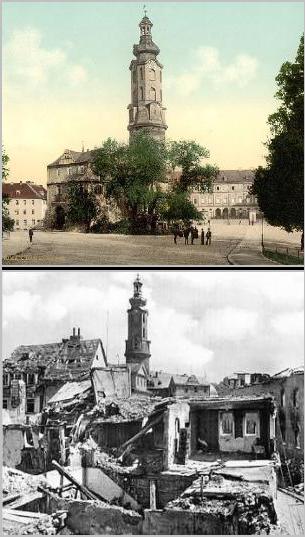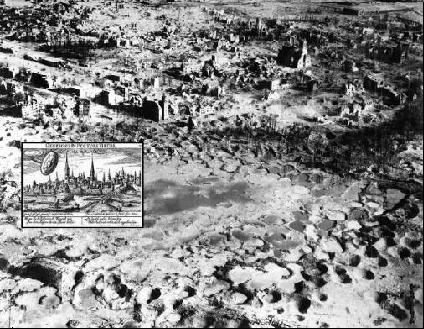

Tilsit was hit by 14 British air strikes. The worst attack was on July 26 /27, 1944 when the historic old town center was completely burned out and 25,000 dwellings were lost. Many people who had not already fled left now, only to join thousands of other frantic refugees facing a grim and uncertain future. Tilsit then sank into oblivion as part of the “Kalingrad Oblast.”
Shortly before American and Soviet troops linked up at Torgau on the Elbe in their historic April, 1945 meeting, an event which hastened the close of war and the defeat of Germany, Torgau’s vicinity was hit simultaneously in a strike by over 100 US bombers. A monument was built in Torgau to honor the “liberation,” but no monument was built to commemorate the plundered of the Hohner accordion and harmonica factory by the Red Army or the prison camps it opened there after Torgau was sentenced to decades of communist slavery.
On April 20, 1945, the British sent 42 bombers to bomb the town, and the next day it fell to the Red Army, and a horrific massacre of civilians took place.
MassacreDuring the War of Palatinate Succession in 1688, many cities in the electorate were systematically destroyed by the French. Nearly all castles were blown up and the only bridge across the Moselle at Trier was burnt. As the French Army retreated in 1698, it left a starving city without its ancient walls and with only 2,500 inhabitants left alive. Abused and coveted by France, Trier managed to eventually recover.
The Allied Destruction of Ancient Trier
The ancient German Cathedral cities seemed to have been favorite targets of the Allied bombers. Ulm was, for its size, the most heavily bombed city in southern Germany, especially toward the end of the war when it lay defenseless. Water-filled bomb craters covered blocks where parks, factories and houses once stood, and the rubble was so thick that walking was almost impossible.
Above this, the 500 year-old Gothic cathedral stood weeping, towering above the grey hulk of yet one more city which had stood from before the middle ages until the madness of Allied bombing. The heaviest bombs fell upon Ulm on December 17, 1944, causing a lethal firestorm which killed almost 800 people and hideously injured scores more. Approximately 25,000 humans lost their homes. After the war, the priceless old city center was 81% destroyed, and only 1,763 out of 12,756 buildings were left intact. 4,400 Ulmers died in the war.
In April, 1945, Americans pounded the old castle and its small village to rubble, reducing it by 80% because they thought it might be a hiding place for soldiers. In the aftermath of their carnage, the GIs lit numerous fires and destroyed a valuable art collection which had been taken there for safe keeping.

In bomb attacks aimed at cultural landmarks by the U.S. on February 9, 27 and March 10, 1945, the city was hit with 965 tons of bombs. In the first attack, 300 residents lost their lives. All of the buildings on the north side of the market square were lost. 325 historic buildings were destroyed, including the National Museum and the National Theater. A further 210 were severely damaged, including the 18th century homes of Goethe and Schiller and the Royal Palace. All of the historic buildings on the north side of the main town square were destroyed. On July 3, 1945, Weimar was given to the Communists and it languished as part of East Germany until reunification.

In 1407, Wesel joined the Hanseatic League and, next to Cologne, Wesel became the second most important transport and shipping center for goods being imported from the Netherlands, Westphalia and other distant places. Wesel was one of the best examples of the late Gothic period and home to master builders, carvers, painters and goldsmiths of the late Middle Ages. Wesel’s history was Germany’s history, encompassing the Reformation and the Thirty Years’ War. From 1540 on, Wesel was a Lutheran town, attracting many religious refugees from the Netherlands which were occupied by the Spanish. The willingness of the city to protect the persecuted was rewarded by its secondary name “Vesalia Hospitalis.”
Shortly before end of the Second World War, the town of Wesel was wholly obliterated. From 1940, it experienced many air raids, but they grew to almost daily attacks from the beginning of the year 1945.On February 16, 17 and 18 of 1945 the devastating, ultimate destruction of Wesel finally arrived. 100 bombers, each with a 6,000 kg.load attacked on the 16th. On the 18th and 19th, 328 bombers dropped their deadly load.
The once proud Hanseatic city had its guts ripped out. 7693 dwellings, 8 schools and 3 churches were gone. However, this was not the end. On February 23, 1945 the Americans joined in. On the afternoon March 23, 1945, in operation “Plunder,” an enormous artillery bombardment on the ruins of Wesel commenced, and another 200 bombers battered Wesel with 1,100 tons of bombs and aerial mines. Another city that had stood since the Middle Ages was 98% pulverized, thousands were dead, leaving 2.1 million cubic meters of rubble.
The outskirts of the town became industrialized in the 20th century and therefore became a bombing target. Although the historic district was mostly spared, the old cathedral suffered heavy damage. At war’s end, the town’s population doubled from the huge numbers of refugees flooding into the town from the east.
Aside from its airfield, Wiesbaden was not heavily bombed in World War Two. In the one and only RAF raid on Wiesbaden, 495 Lancasters and 12 Mosquitos were sent but accomplished little besides having three of their Lancasters crash in France. Important war industries along the Rhine were left untouched and the railway station was only slightly damaged.
The Merians